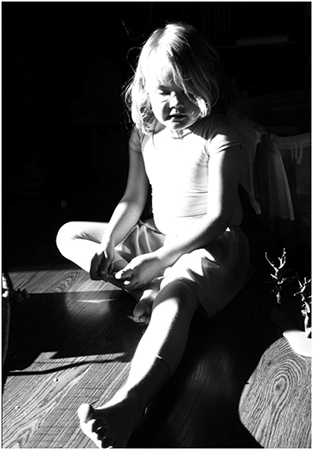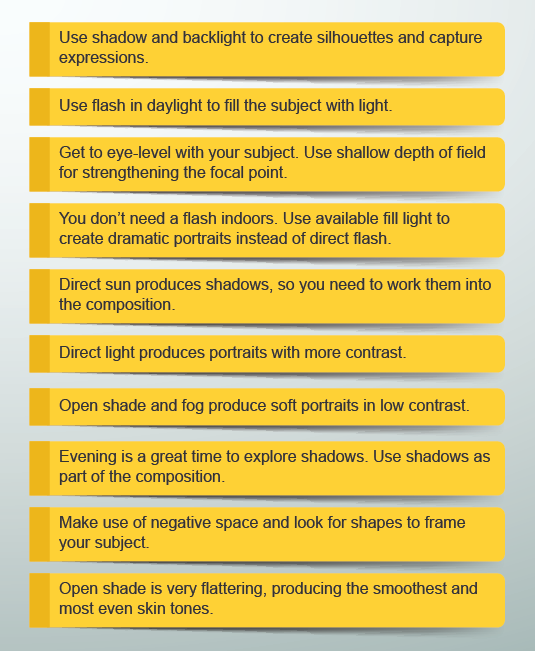Week 8
Strike a Pose

Portrait of woman in open shade.
Woman smiling in vertically oriented photograph
shows the flattering qualities of open shade.
Welcome to Week 8. This final week, you will explore portraiture, which is an essential theme of the history of photography. You are required to read the final chapter in your textbook, which focuses on the history of photography. While doing your shooting assignment this week, think about how the portrait has changed over time, going from a documentary-type object to a work of art that captures emotion, character, and personality. While distinct from each other, fine arts photographers, photojournalists, and portrait photographers all find common ground in the history of the portrait.
This week, you will produce four photographs that use four different styles of lighting. You will work with direct light, direct with fill light, open shade, and shadow to create portraits with strong emotional qualities. Be sure to review the assignment presentation as well as the lecture on emotion in portraiture before you begin your assignment.
Weekly Objectives
-
Learn proper digital camera operation.
-
Learn color evaluation and color correction techniques.
-
Explore experimental lighting and digital special effects.
-
Learn proper resample techniques.
-
Learn basic digital image enhancements using image editing programs.
-
Present digital photographs using basic design principles.
-
Use the fundamental design elements effectively.
Activities
Readings
-
A Short Course in Digital Photography
-
Chapter 10: History of Photography
Activities
-
Discussion 8
-
Shooting Assignment 8
-
Quiz 8
Emotions in Your Portraits

Portrait of young girl with strong shadow.
To explore the emotion in your portraits, you need to consider your subject matter and choose the type of emotion you want to express. After you choose an emotion, you can emphasize it through a new perspective: get below your subject matter, explore getting as close as your lens can focus, or stand above the subject. You can also explore tilting the camera. These are mechanics that you have practiced already with other assignments.
Lighting is essential for a successful emotionally charged image. Ideal scenes include outside locations with open shade, sunlight, fog, or shadows. You can explore background cloths, such as patterned fabrics, scarves, or other simple costume items. You can use props as well. Negative space is also very helpful to give the viewer space to interpret the image and frame the subject. Finally, when working with a person, gaze is essential. Where the subject (model) is looking can cause heightened emotional tones in the image.
Tips for Portrait Photography
Review the following portrait photography tips.

You can also download a Word version of Tips for Portrait Photography.
Strike a Pose: Exploring Emotion and Light in Portraits
Select the play icon, or use the Enter key to watch the video.
This video contains example images for the portraits you will be taking this week, including four different types of lighting.
Additional Learning Resources
Museum of Contemporary Photography
Visit the website: Museum of Contemporary Photography.
Visit this website to take a close look at how the history of photography has influenced photographic artists of today. Look at work by photographers of the 21st century.
Fraenkel Gallery
Also, visit the website: Fraenkel Gallery.
View photographers in the online Fraenkel Gallery to supplement the history of photography reading. Look at work by photographers of the 20th and 21st centuries.
Conclusion
This week, you have learned about the history of photography and viewed several examples of portraiture. You have learned to explore different types of lighting in portraiture with a focus on creating emotion in your images.
While it does not take too long to learn the technical side of becoming a photographer, learning to be a photographer takes time and conscious effort. Quality picture making takes practice and effort. As you move from this class, continue building on your skills. Take advantage of image making opportunities by considering how you can apply formal elements of design to your photographic intentions. The more you do this—for example, by considering angle, orientation (like horizontal or vertical), perspective (worm's eye and bird's eye), and lighting—the better your images will become. Eventually, it will be second nature. Also, don't just take one shot. Always take multiple shots with different viewpoints. Even seasoned photographers take the time to do this.
Take the time to look at other photographers’ works, as well. If you are live in a city that has museums, check if they have photography exhibits. The Museum of Contemporary Photography in Chicago is a great place to visit. The St. Louis Art Museum, which is free, has visiting exhibits that feature the works of people like Sebastião Salgado. The more photos you take, and the more photographers’ works you look at, the more you will improve. We hope you have had an enjoyable experience in photography at Columbia College. Best of luck!